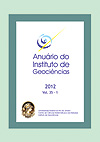Beachrocks from the Cabo Frio Island: unique geological record of the pleistocene - holocene transition in Rio de Janeiro State
DOI:
https://doi.org/10.11137/2012_1_236_241Abstract
The Cabo Frio Island, Rio de Janeiro State, southeast Brazil shows four bodies of beachrocks, emerged up to +1.5 m and submerged down to - 4.5 m. These bodies are constituted of discontinuous strips, parallel to the coastline. Beachrock is beach sediment that has been cemented within the intertidal zone. Like the beach itself, it represents a transition between the marine and meteoric environments, where it is commonly elected by processes from each. Because beachrock is lithified within the intertidal zone and because it commonly forms in a few years, its potential as an indicator of past sea level is important. Four beachrocks samples were analyzed by polarizing microscope. This study indicated that carbonate elements that constitute most of the samples were at least partly incorporated within the intertidal zone. The adequate method for radiocarbon dating (total sample or cement) was decided according to these observations. The dates obtained from Cabo Frio island beachrocks indicate 4 separate sea level stands: the first one at about + 1.5 m around 13.000 BC, the second one at about 0.0 around 12.500 BC, the third at about - 3.0 m around 11.000 BC and finally the fourth sea level at about - 4.5 m around 10.000 BC. The results suggests that between 13.000 to 11.000 yr BP, a sea level fluctuation was around 6,0 m, corresponding probably to negative fluctuation of - 4.5 m and positive fluctuation of + 1.5 m. On the coast of Rio de Janeiro State, Brazil several relative sea level positions are recognized. The more important was the Malhada mash to the north area, a great marine transgression around 5.000 years B.C.Downloads
Download data is not yet available.
Downloads
Published
2012-06-01
How to Cite
Castro, J. W. A. (2012) “Beachrocks from the Cabo Frio Island: unique geological record of the pleistocene - holocene transition in Rio de Janeiro State”, Anuário do Instituto de Geociências. Rio de Janeiro, BR, 35(1), pp. 236–241. doi: 10.11137/2012_1_236_241.
Issue
Section
não definida
License
This journal is licensed under a Creative Commons — Attribution 4.0 International — CC BY 4.0, which permits use, distribution and reproduction in any medium, provided the original work is properly cited.















